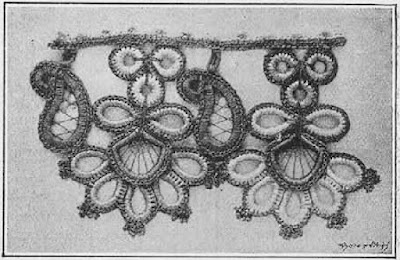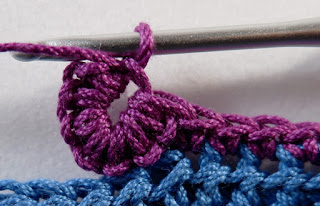Will I ever cease to be amazed by those wildly creative Victorian crocheters? Covering rings in crochet stitches is a modern thing, right? Well apparently not!
Last month I was tediously button-hole stitching around the edge of my Dorset button, dragging metre after metre of thread through each stitch. It was twisting and wrapping itself in knots. Of course it occurred to me that it would be so much easier if I crocheted around the metal ring. Perhaps that was unheard of back in the 18th century but certainly by the late 19th century it was an art form. Not just rings but ovals and all manner of fancy motifs.
If you do a quick 21st century image search on the topic you may find Christmas Tree decorations, coasters, belts, and beaded-style curtains. You will also see super sized creations using wooden craft rings.
The Victorians, on the other hand, were making napkin rings, lamp mats, window shades and trimmings, edgings and decorations for everything from bags to bell pulls.
Their work may be seen as an extension of Irish crochet, where the work began over a padding of gathered threads or cord to give a relief texture. But it also borrows from the gilded braiding used particularly on military uniforms.
While today we crochet over anything which comes to hand, back in the waning years of the 19th century Carl Mez & Söhne was supplying the card moulds illustrated here. At first this company was unfamiliar to me until I read it's history and discovered that it later became J&P Coats, Schachenmayr and MEZ. I found them mentioned in two articles; one from the English Cassell's Family magazine, 1894 and the other from the American Ladies' Home Journal, 1892.
Being, unfortunately, back in the 21st century and having only what I have to hand let's see if there is anything here that we can recreate. Firstly using the instructions from the English Cassell's Family Magazine:
- We cover the ring with closely worked double crochet (Sc-US) and then add an additional round of double crochet in a metallic thread.
- The ring is covered in double crochet, as before, but then add three rounds of single stitches without increase or decrease. I am assuming that 'single' means slip stitch. For those of you who have not attempted Victorian crochet instructions, it should not be assumed that the English Cassell's are using English terminology or that the American 'Ladies Home Journal' is using American terminology! Each round of Slip stitches is made into the back loop only, this is what makes the stitches stand up and curl inwards. It took me some time to work this out. I actually made 4 rounds to get mine to match more closely the illustrations.
- Now after covering the ring, as before, I finish with Bullion stitches which is my least favourite of all stitches. But for you, dear reader, I have attempted it! I will not tell you how many times I attempted this. The instructions are for 12 to 14 wraps but after numerous disasters I went down to just 8 wraps per stitch.
- As I wasn't thrilled with the result I decided to try a modernised version and worked a ring of folded stitches. I chose to work Double Treble stitches (Treble-US) and use Dc (Sc-US) to fold them. You can find out how to make those stitches in this post.
- I am working two rounds of double crochet (Sc-US), the second with picots. There are two different instructions for picots given, although as you know there are many ways to make picots, we shall stay authentic to this article!
- Picot1. Dc, *Ch4, place the hook in the front loop of Dc just made and into next dc from row below, Yarn over and pull through the stitch and pull through both loops on the hook at the same time, Dcx2, repeat from*.
- Picot2. *Dc, Ch4, Dc into dc just made, skip 1 stitch. Repeat from*. This instruction was confusing so I tried various ways to Dc into Dc just made and in the end went with: Place the hook down behind front loop and out behind left leg of 'Dc just made', pull up a loop, yarn over and pull through 2 remaining loops on the hook, creating a Dc. This creates wider picots.
- For this first example I used a herringbone stitch which is described in my embroidery stitch dictionary in the section on Drawn Thread Work. As this is the one and only time I have attempted the stitch I am not going to try and walk you through it. But this link takes you to an expert who will. What I did was, after completing the outer most Dc round, I threaded a needle and took the thread down inside the stitches at the back of the ring before working the centre and fastening off on the back afterwards.
- I thought we could try a Dorset button centre. This time after finishing the outer round of stitches I took the thread, on a needle, down and in through the base of the stitches I had just made and created the network just as we did last month.
Incidentally you may wish to know that the rings I used in the examples are the white rings seen here from Prym. Although I am not sure if they are still available, as they have been gathering dust in my cupboards for quite some time! I used the Anchor Metallic Fine gold thread and found that 6-strand embroidery floss covered the rings beautifully.
Inspired
by a pattern for 'French Lace' from the 1891 publication, The Art of
Crocheting, I decided to see if I could translate the pattern to
accommodate my rings instead of working over thread. This time I chose to use some KnitPro knitting stitch markers, size large. The image shows one pattern- repeat or Scallop of the lace. Örgü Modelleri Tasarim has a pattern on YouTube. The rings she is using are about the size of the KnitPro medium stitch markers. So I have made just a small section based on that design. What is interesting about the design is that there is no inner ring of stitches. The work is made in rows, with half the ring being covered on the first row and the remainder being covered on the return row. It works up very quickly. The video is well worth viewing.This was intended to be a discussion of how the Mez card moulds were used in the 19th century, but coincidences do happen. I needed to make a quick gift for someone who lives on the Isle of Man. For those of you not familiar with the UK that is the island half way between the west coast of Northern England and Northern Ireland. The coat of arms and flag for the Isle of Man includes a Triskelion, a three legged design. I found a pattern on Ravelry by Michele Marshall for a Triskelion Trivet. This would have been perfect for Herr Mez' card rings, instead it uses the rubber seals used on glass jars. Michele says that her pattern was based on a trivet her Grandmother had owned, so perhaps crocheters back in the day were also making use of whatever came to hand!
Useful links:
The Ladies' Home Journal, November 1892
Örgü Modelleri Tasarim, YouTube
Michele Marshall's Triskelion Trivet, Ravelry




































